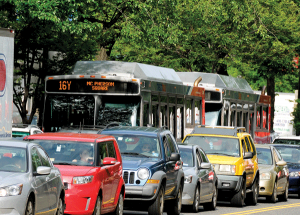 Strategic planning is the process of determining what an organization does, where it wants to be and how it plans to get there. Organizations with well-defined strategic plans have the distinct advantage of clarity of common direction. It offers discipline, focus, and results-orientation, enabling the entire enterprise to focus its talents and energies and to measure achievements against expectations and potential constraints. At Metro, it also provides leaders clear direction for prioritizing decisions around improvements, investments, expansion, operations, and maintenance.
Strategic planning is the process of determining what an organization does, where it wants to be and how it plans to get there. Organizations with well-defined strategic plans have the distinct advantage of clarity of common direction. It offers discipline, focus, and results-orientation, enabling the entire enterprise to focus its talents and energies and to measure achievements against expectations and potential constraints. At Metro, it also provides leaders clear direction for prioritizing decisions around improvements, investments, expansion, operations, and maintenance.
Metro needs a strategic plan for all of the above reasons and more. The organization is implementing hundreds of improvements to rehabilitate the system via MetroForward and instilling management discipline to the organization through the General Manager/CEO’s business plan. These efforts will have positive effects in the near term, but will be insufficient to prepare the system and organization for the challenges to come. Read more…
 You’ve been diligently telling us what you think our priorities should be and we’ve listened. We’ve been hard at work putting the final touches on Momentum: The Next Generation of Metro and Metro’s Board endorsed the plan today.
You’ve been diligently telling us what you think our priorities should be and we’ve listened. We’ve been hard at work putting the final touches on Momentum: The Next Generation of Metro and Metro’s Board endorsed the plan today.
Starting Monday, over the following 40 weekdays, we’ll be rolling out the most interesting parts of the plan in daily posts here on PlanItMetro.
Monday Posts: Preparing for Tomorrow’s Region Today
Tuesday Posts: Metro’s Importance to the Region
Wednesday Posts: Metro’s Recent Accomplishments and Public Engagement
Thursday Posts: Strategies and Priority Actions to Make this Vision a Reality
Friday Posts: Metro 2025 – Seven Priority Capital Initiatives
If you want to read and download either the full Momentum plan or the Executive Summary, go right ahead. But if you want to stop back for a daily dose of Momentum, don’t be shy. If you notice something that strikes your fancy, leave us a comment.
Regional support is important to making Momentum a reality! A number of regional stakeholders have already endorsed Momentum. Please sign on and add your name to endorse Momentum and send the message that public transit is vital to the National Capital Region.
Categories: Momentum Tags: 40 Days of Momentum, Board, business case, forecasts, history, maps, Metrorail, MindMixer, Momentum, planning, plans, priority, public comment

Since Metro’s MindMixer site opened on September 27th, the response has been overwhelming. To date, we’ve had over 425 participants provide more than 1900 votes, 450 comments, and115 ideason a range of topics. The first round of questions generated over 150 pages of comments alone! The site is expected to continue through the end of the year at a minimum, so please continue to join the conversation.
Metro is using MindMixer to start a conversation with our customers about how they envision the next generation of Metro. A quick review of the site shows a wide range of comments and ideas, some that are short-term and many that are very far in the future.
All comments and ideas are being reviewed as part of Momentum: The Next Generation of Metro, the agency’s strategic plan. Metro staff is responding to some of the comments and ideas as they are posted. Often this is to direct a participant to work that is already underway or to provide short responses or explanations of current policies. Other ideas have created discussions between participants, which is one of the main purposes for the site. The vast majority of ideas and comments require further study, more discussion of what is possible within Metro’s environment, and/or prioritization among other needs at Metro. Many of the ideas also require substantial resources to implement.
As the site continues, we are collating and summarizing your comments and ideas based on themes, such as core capacity, information provision, and non-Metro expansion. This high level summary will be used to support Momentum, our strategic plan, as it provides an indication of the elements that are most important to you, our riders. We will also be taking comments directly from MindMixer to incorporate in the strategic plan document. As part of this blog, we will be further developing some of the ideas and comments to form the basis for a Metro 101 section on PlanItMetro. These posts will help increase the level of understanding of transit in this region. Lastly, for those ideas that require further study, they will be compiled and when MindMixer concludes, this information will be circulated to the respective Metro departments. This will help ensure that decision makers throughout the organization review the thoughtful ideas that have been provided on MindMixer.
Categories: Momentum Tags: 101, Board, Metro 101, MindMixer, Momentum, planning, plans, priority, public comment, studies, survey
In September, we presented to the TAG the results of the first round of scenarios modeled in the second phase of the RTSP study. Scenarios are defined by a collection of strategies or projects identified in the initial phase of the RTSP. The four scenarios tested focused on maximizing the existing infrastructure, expanding surface transit, expanding transit in the core, and expanding transit system wide. The performance of each scenario was evaluated against a set of measures to determine the relative effectiveness of each compared to the baseline scenario, defined by the regional list of projects in the currently adopted Constrained Long Range Plan, and MWCOG Cooperative Forecasts Round 8.0 land use.
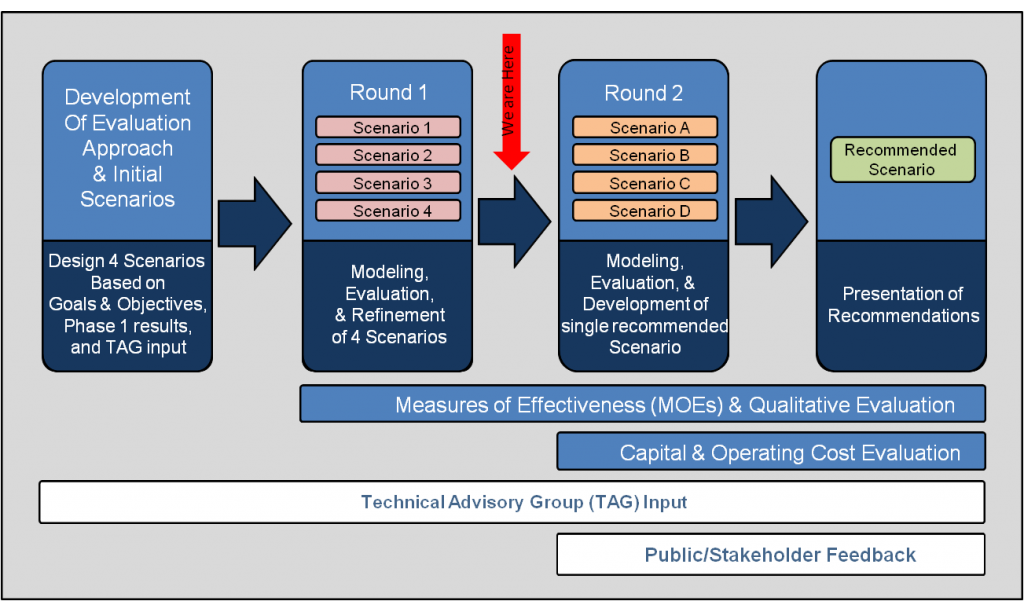
Phase II Process Overview: Click to Enlarge
Regional measures such as total transit trips, mode share, vehicle miles traveled, households and jobs within a half-mile of transit, travel time savings, and transit congestion were evaluated to not only determine how well the scenarios performed against each other over the baseline, but to assess how well each satisfied the goals and objectives of the RTSP. In addition to these broad-based regional measures, the first round of scenario modeling focused on how well each scenario addressed the need to expand capacity within the system core. Peak period Metrorail link capacity and transfer activity at key core stations were measured against the baseline scenario to determine if the potential build scenarios could provide sufficient capacity to serve future demand, and how well such added capacity could be utilized.
For more information on scenario descriptions, measured results, and key findings download meeting materials: TAG 9 Presentation of Results
Read more…
Metro is developing the Regional Transit System Plan (RTSP), a vision of a sustainable, integrated, multimodal, regional transit net work for 2040. Metro staff have recently completed the first phase, and presented a summary to the Technical Advisory Group (TAG) in January. Phase II is underway, and the proposed approach and initial scenarios to evaluate were also presented to the TAG.
work for 2040. Metro staff have recently completed the first phase, and presented a summary to the Technical Advisory Group (TAG) in January. Phase II is underway, and the proposed approach and initial scenarios to evaluate were also presented to the TAG.
During the initial phase, Metro staff assessed future growth trends and travel-demand patterns throughout the region for the forecast year 2040. Regional growth, reported by MWCOG Cooperative Forecasts Round 7.2a, shows significant population, household, and employment growth over the next several decades. This growth has a direct impact on travel patterns around the region. As a part of Phase I work, Metro staff identified the implications this has for transit.
Forecasts show that with the implementation of the projects included in the 2009 financially constrained long-range plan (CLRP) regional transit trips will grow by 30% by 2040. Although the regional program of projects in the CLRP results in a transit mode share remaining at only 4% of total person trips, the region will see more than 350,000 new weekday transit trips. Given the anticipated growth and dispersion of travel, the RTSP focuses on the following long-range issues:
- Increasing the capacity of the system to serve the region’s employment core;
- Improving multimodal access to high quality transit;
- Improving the efficiency and interoperability of the region’s surface transit;
- Improving connections to Regional Activity Centers;
Read more…
May 5, 2011

In May, we continued to provide the TAG with model results of several strategies aimed to improve surface transit in the region, such as an enhanced priority corridor network, streetcar network, and light rail extensions. This round of modeling also tested new Metrorail lines including a beltway line and new brown line. Finally, additional Metrorail enhancements were considered such as a relocated silver line with a Ballston-Rosslyn bypass, and a new set of extensions to suburban activity centers. The results of these model runs show the impact of each of these strategies on weekday transit boardings by mode, Metrorail boardings by line, regional transit share, regional transit linked trips, as well as an examination of passengers per rail car during the peak hour. The strategies modeled during this round address the need to increase core system capacity, connect to new and emerging markets, and provide priority for and enhancements to surface transit corridors in the region – three of the four goals of the RTSP.
Download the Meeting Materials: TAG_07_Meeting.pdf (PDF, 3.1 MB)
The Regional Transit System Plan (RTSP) is intended to update the currently adopted Transit System Expansion Plan (TSEP) that was completed in 1999. In its implementation, the RTSP looks beyond the planning horizon of the TSEP by an additional fifteen years and incorporates updated travel demand, population and employment forecasts for the region. The following discussion will look at how much ridership growth has occurred over the ten-year period between 1999 and 2009, and will look at changes in the regional growth projections out to 2040 that will shape future demand for transit services.
Changes in Ridership
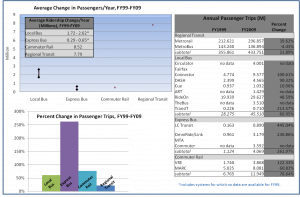
Figure 1. Change in ridership. Source: NTD
As envisioned in the adopted plan, transit ridership has grown since 1999, and is on the way toward the TSEP goal of doubling ridership by 2025. Annual transit passenger trips throughout the region have increased by about 30% in the first 10 years of the 25 year planning horizon. However, this growth in ridership has not been consistent across the region: close inspection of these data shows that ridership growth is happening at a faster rate on local feeder bus, express bus, and commuter rail services than for regional Metrorail and Metrobus services, although Metro accounts for the majority of the growth in absolute terms. The growth in ridership on local and commuter transit services highlights the need to create a transit plan that looks beyond the services provided only by Metro and to focus on the region at large.
Read more…
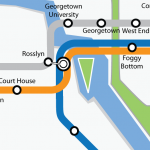
The planned Metrorail Line to Dulles Airport will provide a high-frequency, high-capacity link between the airport and the region’s core, and will enable travel between all Metrorail stations and the airport, without requiring rail-to-bus transfers. Concerns have been expressed about the likely Metrorail travel times between the airport and the core, and the capacity of the Metrorail system, as trains converge through Rosslyn and pass under the Potomac River. Could there be improvements that would provide faster service, expand the capacity, and also provide for greater flexibility for routing trains when service is disrupted, because of either incidents or planned major maintenance?
To attract riders, transit travel times need to “be competitive with” other travel options, yet setting that competitive bar at the level of auto travel times doesn’t seem to be necessary (nor is it readily achievable.) Reagan National Airport attracts many transit trips, even though driving times to the airport are generally shorter than by rail. While travel times need to be competitive, and a faster travel time would be more appealing and attract some more ridership, Metrorail to Dulles Airport will result in considerable transit usage by airport patrons and employees, not only to and from the core, but to Tysons Corner and other locations served by the Metrorail network.
Read more…
 In January 2011 we continued to provide the TAG with model results of several strategies designed to provide more access to transit. The model results of these strategies highlight the myriad methods that can be employed to meet future transit demand in the Washington metropolitan area. During this presentation we also presented the proposed RTSP public engagement strategy; a revised project schedule and solicited jurisdictional representatives for additional strategies they would like to see modeled.
In January 2011 we continued to provide the TAG with model results of several strategies designed to provide more access to transit. The model results of these strategies highlight the myriad methods that can be employed to meet future transit demand in the Washington metropolitan area. During this presentation we also presented the proposed RTSP public engagement strategy; a revised project schedule and solicited jurisdictional representatives for additional strategies they would like to see modeled.
TAG Meeting #6 Presentation (PDF)
The purpose of this strategy is to allow different rail lines to operate on the same track. This type of operation can help reduce capacity constraint on some lines and provide new connections between existing Metrorail lines.
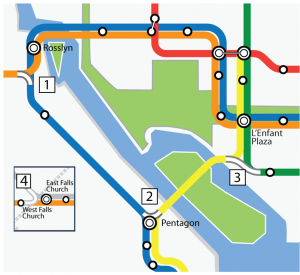 The four interline connections proposed include:
The four interline connections proposed include:
1) Connect Orange and Blue at Rosslyn
2) Connect Yellow and Blue at Pentagon
3) Connect Yellow and Green near L’Enfant Plaza
4) Connect Orange and Silver near West Falls Church
Some benefits of these interline connections include:
- Orange/Silver-Blue inter-lining south of Rosslyn to allow a Silver Line running between the two airports
- BENEFIT: Faster trip to Ballston, Tysons and airports within Virginia
- Blue-Yellow inter-lining north of Pentagon to allow I-66 corridor rail lines going through 14th Street Bridge
- BENEFIT: Utilize throughput capacity on 14th Street Bridge
- Yellow-Green inter-lining south of L’Enfant Plaza to allow a Yellow Line split to Anacostia/Navy Yard
- BENEFIT: Allow direct access between Anacostia and southern Maryland to job sites in southern Arlington and the City of Alexandria.
Additionally, this strategy will explore the benefits of making improvements to several of the system’s core stations:
- Pedestrian tunnel between Farragut North and Farragut West;
- Pedestrian tunnel between Metro Center and Gallery Place;
- Increase amount of vertical capacity at Union Station;
- Increase transfer capacity at the three core transfer stations: Metro Center, Gallery Place and L’Enfant Plaza
 Strategic planning is the process of determining what an organization does, where it wants to be and how it plans to get there. Organizations with well-defined strategic plans have the distinct advantage of clarity of common direction. It offers discipline, focus, and results-orientation, enabling the entire enterprise to focus its talents and energies and to measure achievements against expectations and potential constraints. At Metro, it also provides leaders clear direction for prioritizing decisions around improvements, investments, expansion, operations, and maintenance.
Strategic planning is the process of determining what an organization does, where it wants to be and how it plans to get there. Organizations with well-defined strategic plans have the distinct advantage of clarity of common direction. It offers discipline, focus, and results-orientation, enabling the entire enterprise to focus its talents and energies and to measure achievements against expectations and potential constraints. At Metro, it also provides leaders clear direction for prioritizing decisions around improvements, investments, expansion, operations, and maintenance.










Recent Comments